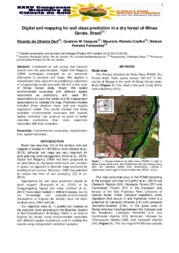Digital soil mapping for soil class prediction in a dry forest of Minas Gerais, Brazil.
Digital soil mapping for soil class prediction in a dry forest of Minas Gerais, Brazil.
Author(s): DART, R. de O.; VASQUES, G. M.; COELHO, M. R.; FERNANDES, N. F.
Summary: Investment on soil survey has become scarce over the past decades. Digital Soil Mapping (DSM) techniques emerged as an economic alternative to produce soil maps. We applied a classification tree algorithm to predict soil suborders in a tropical dry forest area with 102 km2 in the north of Minas Gerais state, Brazil. We tested environmental covariates with different spatial resolutions as predictors, and used 361 observations to train the model and 64 independent observations to validate the map. Prediction models included three decision trees and one logistic regression model. The results showed that freely available environmental covariates with coarser spatial resolution can produce as good or better suborder predictions than more expensive covariates with finer resolution.
Publication year: 2015
Types of publication: Paper in annals and proceedings
Unit: Embrapa Soils
Observation
Some of Embrapa's publications are published as ePub files. To read them, use or download one of the following free software options to your computer or mobile device. Android: Google Play Books; IOS: iBooks; Windows and Linux: Calibre.
Access other publications
Access the Agricultural Research Database (BDPA) to consult Embrapa's full library collection and records.
Visit Embrapa Bookstore to purchase books and other publications sold by Embrapa.

